Abstract
Transient lower oesophageal sphincter relaxation (LOSR) is the major mechanism underlying gastro-oesophageal reflux. The mediation and control of LOSRs are incompletely understood but evidence suggests a neural inhibitory mechanism. In this study we have evaluated the effect of gastric distension on LOS function in 16 patients with untreated idiopathic achalasia and compared it with that in 10 healthy controls. With the subjects sitting, the stomach was distended with a liquid mixture that generated 750 ml CO2. Oesophageal pH and motility were monitored for 10 minutes before and after distension. In normal controls, gastric distension induced a four-fold increase in the rate of LOSRs and gas reflux episodes (as evidenced by oesophageal common cavities), whereas this response was absent in the achalasia patients. Basal LOS pressure did not change in either group. These findings are consistent with the notion that transient LOSRs induced by gastric distension are neurally mediated, probably by the same inhibitory nerves that govern swallow mediated LOS relaxation.
Full text
PDF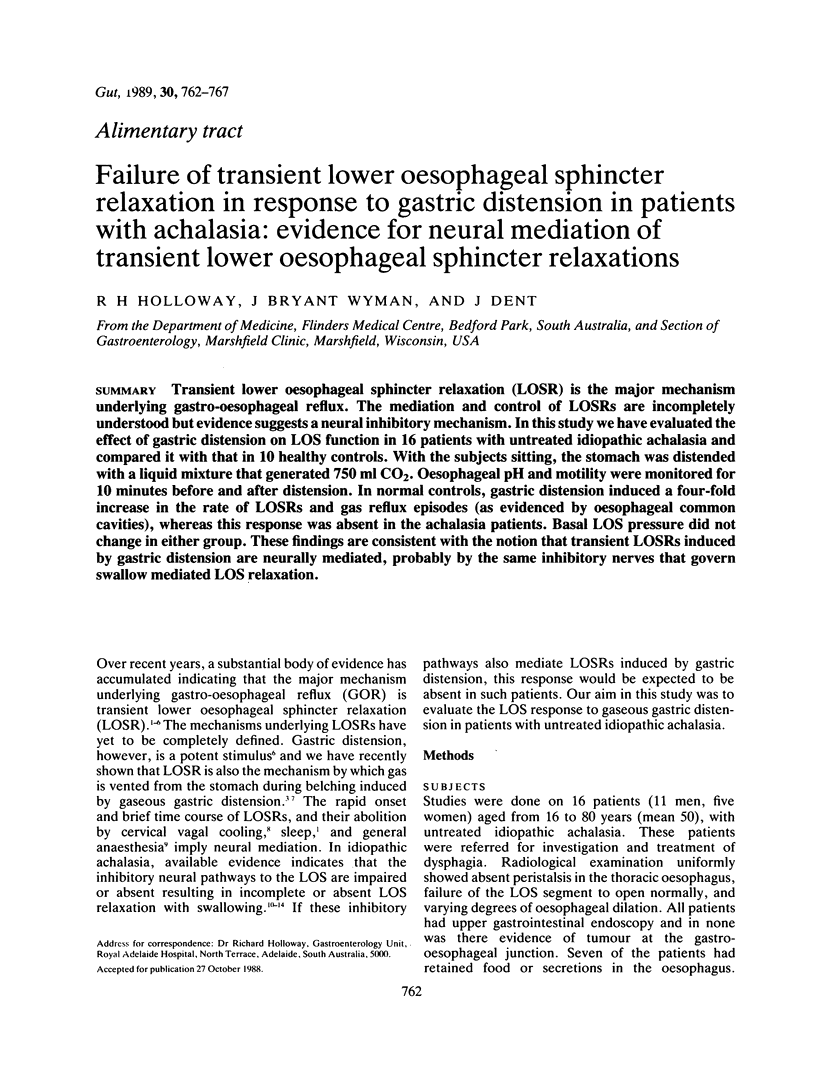
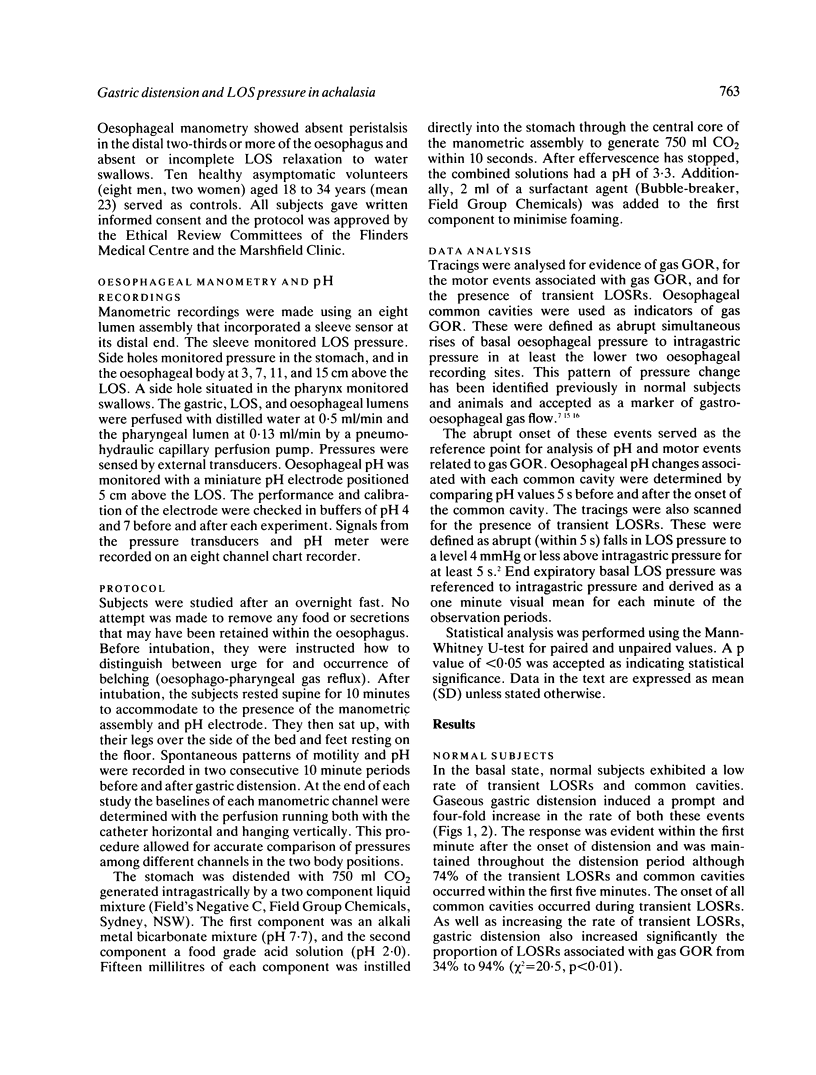
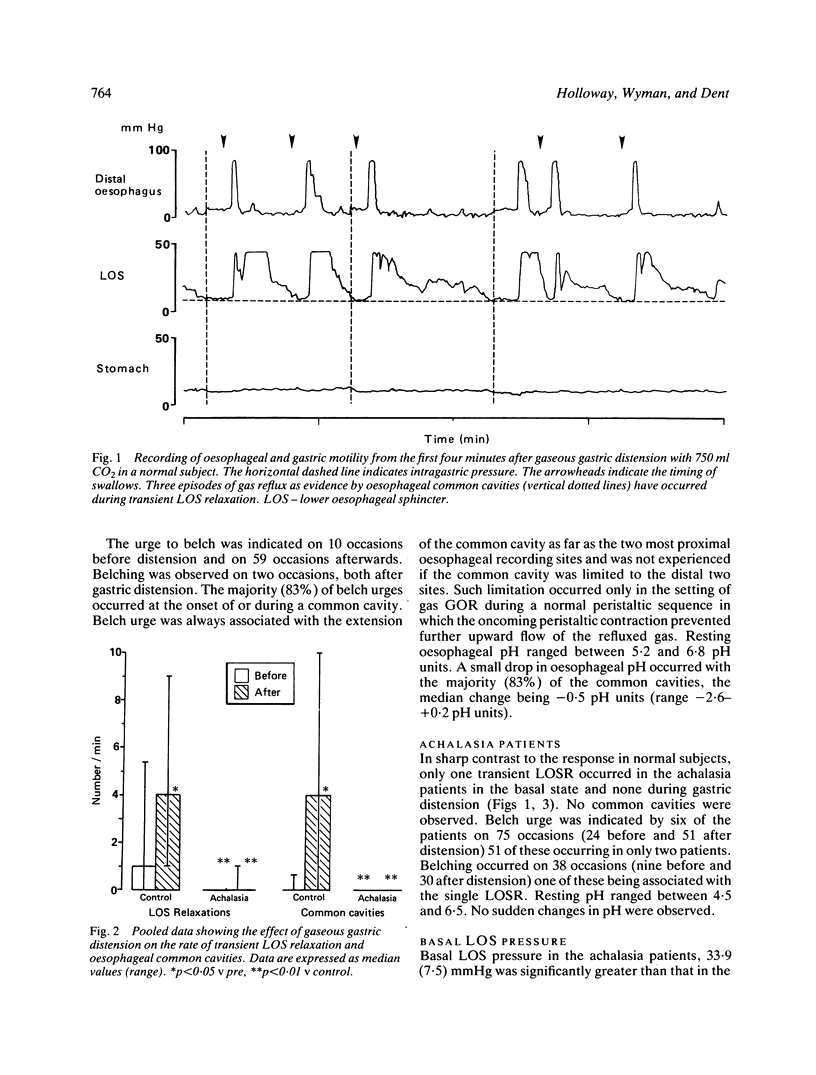
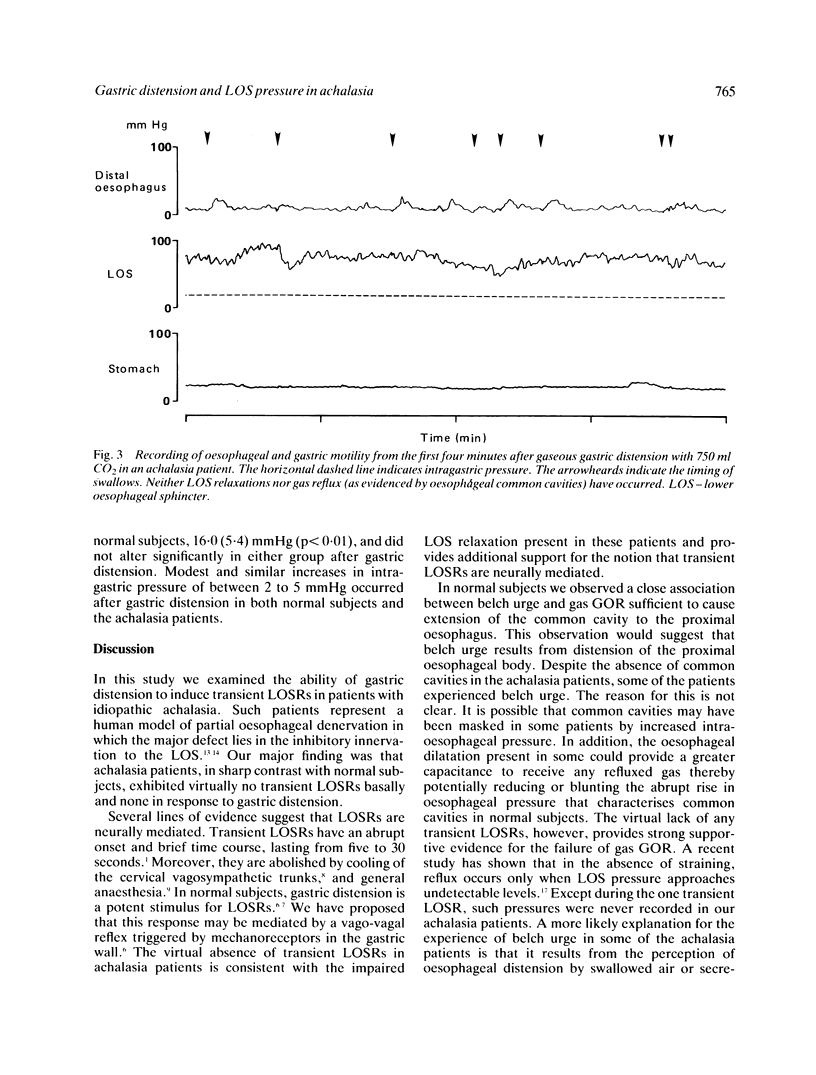
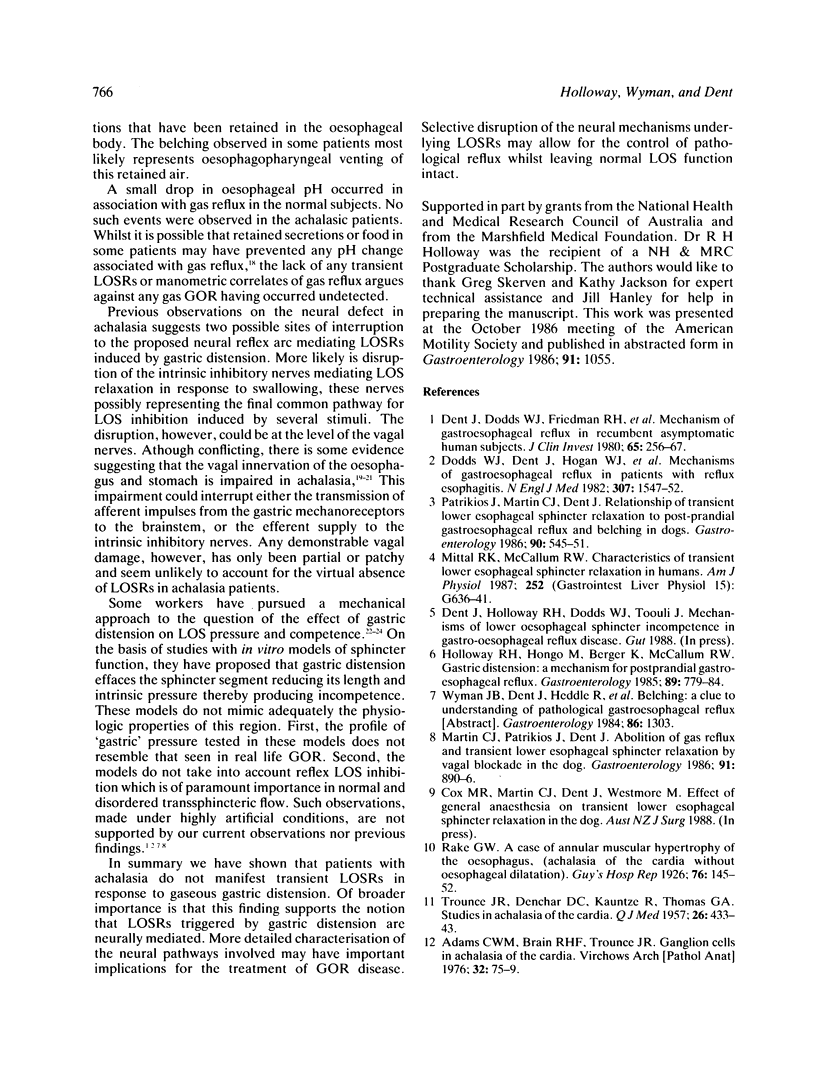
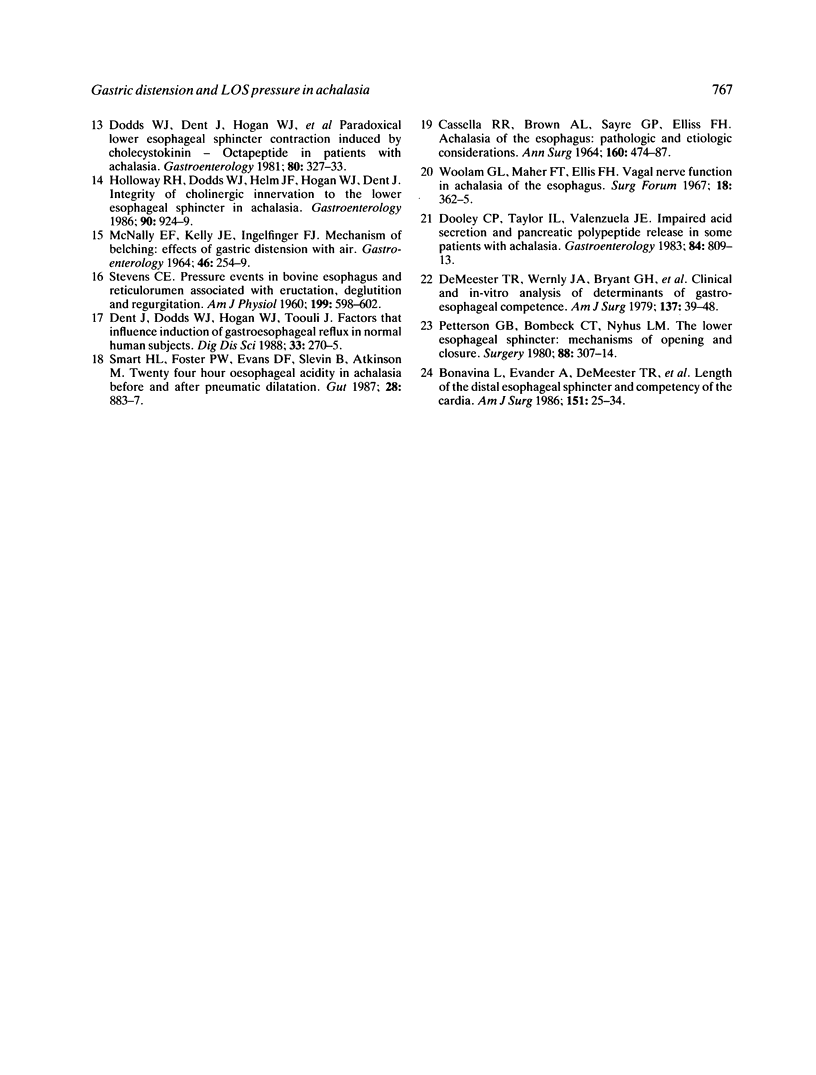
Selected References
These references are in PubMed. This may not be the complete list of references from this article.
- Bonavina L., Evander A., DeMeester T. R., Walther B., Cheng S. C., Palazzo L., Concannon J. L. Length of the distal esophageal sphincter and competency of the cardia. Am J Surg. 1986 Jan;151(1):25–34. doi: 10.1016/0002-9610(86)90007-3. [DOI] [PubMed] [Google Scholar]
- CASSELLA R. R., BROWN A. L., Jr, SAYRE G. P., ELLIS F. H., Jr ACHALASIA OF THE ESOPHAGUS: PATHOLOGIC AND ETIOLOGIC CONSIDERATIONS. Ann Surg. 1964 Sep;160:474–487. doi: 10.1097/00000658-196409000-00010. [DOI] [PMC free article] [PubMed] [Google Scholar]
- DeMeester T. R., Wernly J. A., Bryant G. H., Little A. G., Skinner D. B. Clinical and in vitro analysis of determinants of gastroesophageal competence. A study of the principles of antireflux surgery. Am J Surg. 1979 Jan;137(1):39–46. doi: 10.1016/0002-9610(79)90008-4. [DOI] [PubMed] [Google Scholar]
- Dent J., Dodds W. J., Friedman R. H., Sekiguchi T., Hogan W. J., Arndorfer R. C., Petrie D. J. Mechanism of gastroesophageal reflux in recumbent asymptomatic human subjects. J Clin Invest. 1980 Feb;65(2):256–267. doi: 10.1172/JCI109667. [DOI] [PMC free article] [PubMed] [Google Scholar]
- Dent J., Dodds W. J., Hogan W. J., Toouli J. Factors that influence induction of gastroesophageal reflux in normal human subjects. Dig Dis Sci. 1988 Mar;33(3):270–275. doi: 10.1007/BF01535748. [DOI] [PubMed] [Google Scholar]
- Dodds W. J., Dent J., Hogan W. J., Helm J. F., Hauser R., Patel G. K., Egide M. S. Mechanisms of gastroesophageal reflux in patients with reflux esophagitis. N Engl J Med. 1982 Dec 16;307(25):1547–1552. doi: 10.1056/NEJM198212163072503. [DOI] [PubMed] [Google Scholar]
- Dodds W. J., Dent J., Hogan W. J., Patel G. K., Toouli J., Arndorfer R. C. Paradoxical lower esophageal sphincter contraction induced by cholecystokinin-octapeptide in patients with achalasia. Gastroenterology. 1981 Feb;80(2):327–333. [PubMed] [Google Scholar]
- Dooley C. P., Taylor I. L., Valenzuela J. E. Impaired acid secretion and pancreatic polypeptide release in some patients with achalasia. Gastroenterology. 1983 Apr;84(4):809–813. [PubMed] [Google Scholar]
- Holloway R. H., Dodds W. J., Helm J. F., Hogan W. J., Dent J., Arndorfer R. C. Integrity of cholinergic innervation to the lower esophageal sphincter in achalasia. Gastroenterology. 1986 Apr;90(4):924–929. doi: 10.1016/0016-5085(86)90869-3. [DOI] [PubMed] [Google Scholar]
- Holloway R. H., Hongo M., Berger K., McCallum R. W. Gastric distention: a mechanism for postprandial gastroesophageal reflux. Gastroenterology. 1985 Oct;89(4):779–784. doi: 10.1016/0016-5085(85)90572-4. [DOI] [PubMed] [Google Scholar]
- MCNALLY E. F., KELLY J. E., Jr, INGELFINGER F. J. MECHANISM OF BELCHING: EFFECTS OF GASTRIC DISTENSION WITH AIR. Gastroenterology. 1964 Mar;46:254–259. [PubMed] [Google Scholar]
- Martin C. J., Patrikios J., Dent J. Abolition of gas reflux and transient lower esophageal sphincter relaxation by vagal blockade in the dog. Gastroenterology. 1986 Oct;91(4):890–896. doi: 10.1016/0016-5085(86)90691-8. [DOI] [PubMed] [Google Scholar]
- Mittal R. K., McCallum R. W. Characteristics of transient lower esophageal sphincter relaxation in humans. Am J Physiol. 1987 May;252(5 Pt 1):G636–G641. doi: 10.1152/ajpgi.1987.252.5.G636. [DOI] [PubMed] [Google Scholar]
- Patrikios J., Martin C. J., Dent J. Relationship of transient lower esophageal sphincter relaxation to postprandial gastroesophageal reflux and belching in dogs. Gastroenterology. 1986 Mar;90(3):545–551. doi: 10.1016/0016-5085(86)91107-8. [DOI] [PubMed] [Google Scholar]
- Pettersson G. B., Bombeck C. T., Nyhus L. M. The lower esophageal sphincter: mechanisms of opening and closure. Surgery. 1980 Aug;88(2):307–314. [PubMed] [Google Scholar]
- Smart H. L., Foster P. N., Evans D. F., Slevin B., Atkinson M. Twenty four hour oesophageal acidity in achalasia before and after pneumatic dilatation. Gut. 1987 Jul;28(7):883–887. doi: 10.1136/gut.28.7.883. [DOI] [PMC free article] [PubMed] [Google Scholar]
- TROUNCE J. R., DEUCHAR D. C., KAUNTZE R., THOMAS G. A. Studies in achalasia of the cardia. Q J Med. 1957 Oct;26(104):433–443. [PubMed] [Google Scholar]


